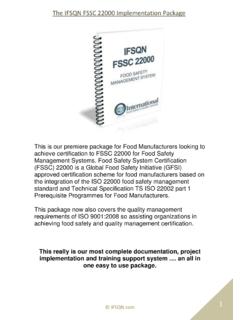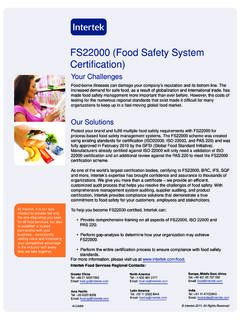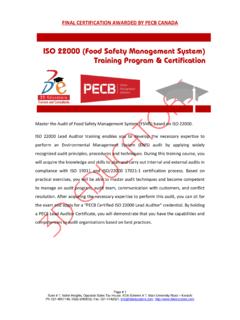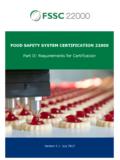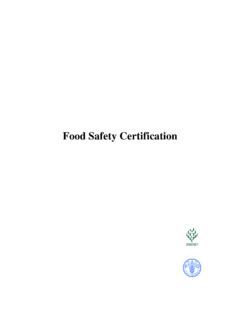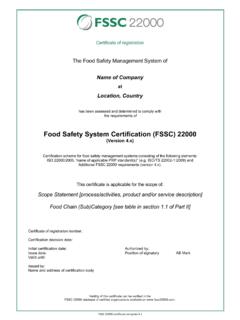Transcription of UNDERSTANDING THE FSSC 22000 FOOD SAFETY SYSTEM ...
1 UNDERSTANDING THE FSSC 22000 food . SAFETY SYSTEM CERTIFICATION SCHEME. A WHITE PAPER ON THE CHALLENGES, IMPACTS AND OPPORTUNITIES CONTAINED IN FSSC 22000 . MAY 2012. AUTHORS. Supreeya Sansawat Global food Business Manager, SGS. Victor Muliyil Technical Manager for North America food SAFETY Services, SGS. ABSTRACT. This document aims to provide an insight into the FSSC 22000 food SAFETY SYSTEM Certification scheme. It is not intended to be a full explanation of the scheme rather it provides an UNDERSTANDING of the standard and its benefits, and gives a specific focus on the Management SYSTEM Standards required for food SAFETY for organisations doing business at a domestic or international level within the food industry. CONTENTS. I. EXECUTIVE SUMMARY 1. II. GLOBAL food SAFETY A CHALLENGING ENVIRONMENT 2. III. THE CORE COMPONENTS OF FSSC 22000 4. IV. A GLOBAL SOLUTION FOR food SAFETY 8.
2 V. NESTL MOVES TO FSSC 22000 TO ALIGN WITH GFSI REQUIREMENTS 9. VI. CONCLUSIOn 10. I. EXECUTIVE SUMMARY. food SAFETY is an issue that will always principles of other GFSI recognised ISO 22000 :2005 standard, FSSC 22000 . be on consumers' minds. Over the years, food SAFETY schemes. This allows works seamlessly with other quality many regional and customised food organisations that achieve FSSC 22000 management systems such as ISO 9001, SAFETY standards have evolved in order certification to meet the requirements ISO 14001 and OHSAS 18001, making it to enhance food SAFETY and address of several global retailers or major an integral part of any food manufacturing the issues raised by manufacturers, branded food companies under a single, organisation's ability to improve quality suppliers, retailers and consumers. internationally recognised food SAFETY food SAFETY and other aspects.
3 In February 2010, the Global food management SYSTEM and allows your Ultimately, FSSC 22000 combines the SAFETY Initiative (GFSI), an organisation organisation to sell its products to major benefits of a business management committed to benchmarking food retailers with confidence. tool linking food SAFETY and business SAFETY management schemes with an FSSC 22000 presents one of the most processes with the ability to meet aim towards fostering a convergence comprehensive approaches to a food growing global customer requirements between food SAFETY standards, fully SAFETY management SYSTEM for those for GFSI recognised supplier food SAFETY recognised the FSSC 22000 scheme engaged in the manufacturing of food SYSTEM certification. which incorporates many of the items. Because of its basis in the 1. II. GLOBAL food SAFETY . A CHALLENGING ENVIRONMENT. Consumers are becoming more and and Critical Control Point (HACCP) sixth standard to join the stable of GFSI.
4 More concerned about food SAFETY . SYSTEM certification's role in food SAFETY recognised schemes. This move helps From tainted milk to contaminated management systems. The result was improve cost efficiency and consistency peanut butter, food scares and recalls ISO 22000 :2005, issued in 2005. Its aim among food supply chains around the have been ever-present during the past was to define food SAFETY management world and delivers greater confidence to several years. Extended global supply requirements for companies that needed the end users of third-party certification chains and lack of adequate control to comply with a wide variety of global whilst providing flexibility and choice in mechanisms are some of the key food SAFETY regulations. certification schemes 1. reasons. As manufacturers and retailers However, ISO 22000 :2005 was not The result is an international, auditable make efforts to address deficiencies in approved by GFSI at the time due to scheme that specifies the requirements their supply chains, and multiple SAFETY weak prerequisite programme content.
5 For food SAFETY management systems standards and schemes are proposed To bolster this content, a group of by incorporating all the elements of and adopted, progress is being made to large multinational companies wrote Good Manufacturing Practices (GMP). ensure global food SAFETY . an addendum to the ISO 22000 :2005 and Hazard Analysis Critical Control The introduction of FSSC 22000 standard known as the Publicly Available Point (HACCP) systems together with marks a major step towards a single, Specification 220 (PAS 220:2008), a comprehensive management SYSTEM . internationally accredited and recognised issued in 2008. FSSC 22000 gives organisations a way superior food SAFETY scheme. It GFSI agreed that the combination of to demonstrate, in an internationally combines the ISO 22000 :2005 ISO 22000 :2005 and PAS 220:2008 understood format, that they have a food SAFETY Management standard contained adequate content for comprehensive management SYSTEM with the detailed requirements for approval, but that there must be an that meets the food SAFETY requirements prerequisite programmes (PRPs) of industry-owned scheme governing the of both customers and regulatory each sector within the supplied chain combination of these two standards, agencies.
6 It brings hazard controls and key additional requirements. The along with emphasis on regulatory and along the food chain under a single food FSSC 22000 scheme has been fully customer requirements. SAFETY management umbrella, making recognised by the Global food SAFETY it easier to train, implement and audit Initiative (GFSI), which is also focused Consequently, the Foundation for the management of food SAFETY at every on improving cost efficiency throughout food SAFETY Certification developed level of the food chain. the food supply chain through the the FSSC 22000 scheme, combining ISO 22000 :2005 standard with In March 2012, PAS 220:2008 was common acceptance of GFSI recognised withdrawn and replaced with the standards by retailers around the world. PAS 220:2008 and some additional requirements with respect to ISO/TS 22002-1:2009 standard to work specifications for services and the in conjunction with the ISO 22000 :2005.
7 The origins of the FSSC 22000 scheme standard within the FSSC 22000 . supervision of food SAFETY related In 2001, the International Organization for activities. FSSC 22000 was approved by scheme. The requirements for the Standardisation (ISO) began developing GFSI in May 2009 as a global benchmark ISO/TS 22002-1:2009 are essentially the an auditable standard for the food in food SAFETY management. Since same in that they detail requirements industry, building on the Hazard Analysis February 2010, FSSC 22000 became the for prerequisite programmes (PRPs). 1. Source: GFSI ( ). 2. THE ORIGINS OF THE FSSC 22000 SCHEME 2004 Feb 2010. International food Standard (IFS) FSSC 22000 fully recognised by GFSI. 1938. launched (a GFSI approved standard). Good Manufacturing Practices are enforced by the US food and Drug July 2011. Administration (FDA) as a result of 2004 Foundation for food SAFETY Certification 1938 food , Drug, and Cosmetic Act.
8 Foundation for food SAFETY announced an extension of scope Certification founded. for FSSC 22000 to cover the food packaging manufacturing sector. 1960s Hazard Analysis and Critical Control 2005. Point (HACCP) principles created. ISO 22000 :2005 issued, not approved August 2011. by GFSI due to lack of sufficient GFSI Guidance Document issued, prerequisite programmes. including food packaging manufacture 1995. requirements. Safe Quality food (SQF) standard launched (a GFSI approved standard). 2007. Top seven retailers agree to reduce October 2011. duplication in the supply chain through the Updated FSSC scheme documents 1998. common acceptance of any of the GFSI including the extension of packaging First British Retail Consortium (BRC). benchmarked schemes (BRC, IFS, SQF or sent to GFSI and all relevant standard introduced (now a GFSI. Dutch HACCP). accreditation bodies for recognition.)
9 Approved standard). 2008 Feb 2012. Late 1990s PAS 220:2008 issued as a way to Foundation for food SAFETY Certification GlobalGAP launched (originally as establish sufficient prerequisite announced the scope of FSSC will be EurepGAP). programmes for ISO 22000 :2005 in extended to include manufacture of food food and ingredient manufacturing. and feed for animals. May 2000. Global food SAFETY Initiative (GFSI). 2009 March 2012. founded. One of GFSI's main FSSC 22000 issued as a combination of PAS 220:2008 is withdrawn and objectives is to benchmark food SAFETY ISO 22000 :2005 and PAS 220:2008. replaced with ISO/TS 22002-1:2009. management schemes with an aim towards convergence between food SAFETY standards. May 2009. Content of FSSC 22000 approved by GFSI. 3. III. THE CORE COMPONENTS OF FSSC 22000 . IN-DEPTH ON ISO 22000 :2005 food SAFETY Management SYSTEM Control Point (HACCP), including any regulatory requirements applicable To fully understand the certification In the food SAFETY management SYSTEM to the organisation and processes.
10 Requirements of FSSC 22000 it is section, the emphasis is on establishing, Adequate prerequisite programmes important to include an overview of documenting, implementing and ( training, sanitation, maintenance, ISO 22000 :2005 and Pre Requisite maintaining an effective food SAFETY traceability, supplier review, control Programs (PRPs) since they form the management SYSTEM . This includes of non-conforming product and recall core of the FSSC 22000 scheme. procedures and records that are needed procedures) are required that address ISO 22000 :2005 was designed to to ensure effective development, and general requirements to provide a cover all the processes along the food implementing and updating of the foundation for the production of chain that deal directly or indirectly food SAFETY management SYSTEM . This safe food . with the end product being consumed. clause also covers the requirement Furthermore, it specifies the requirements for the organisation to take ultimate responsibility for the competent Validation, Verification and for food SAFETY management SYSTEM by incorporating all the elements of Good performance of any outsourced activities Improvement of the food SAFETY Manufacturing Practices (GMP), also that impact food SAFETY control.


